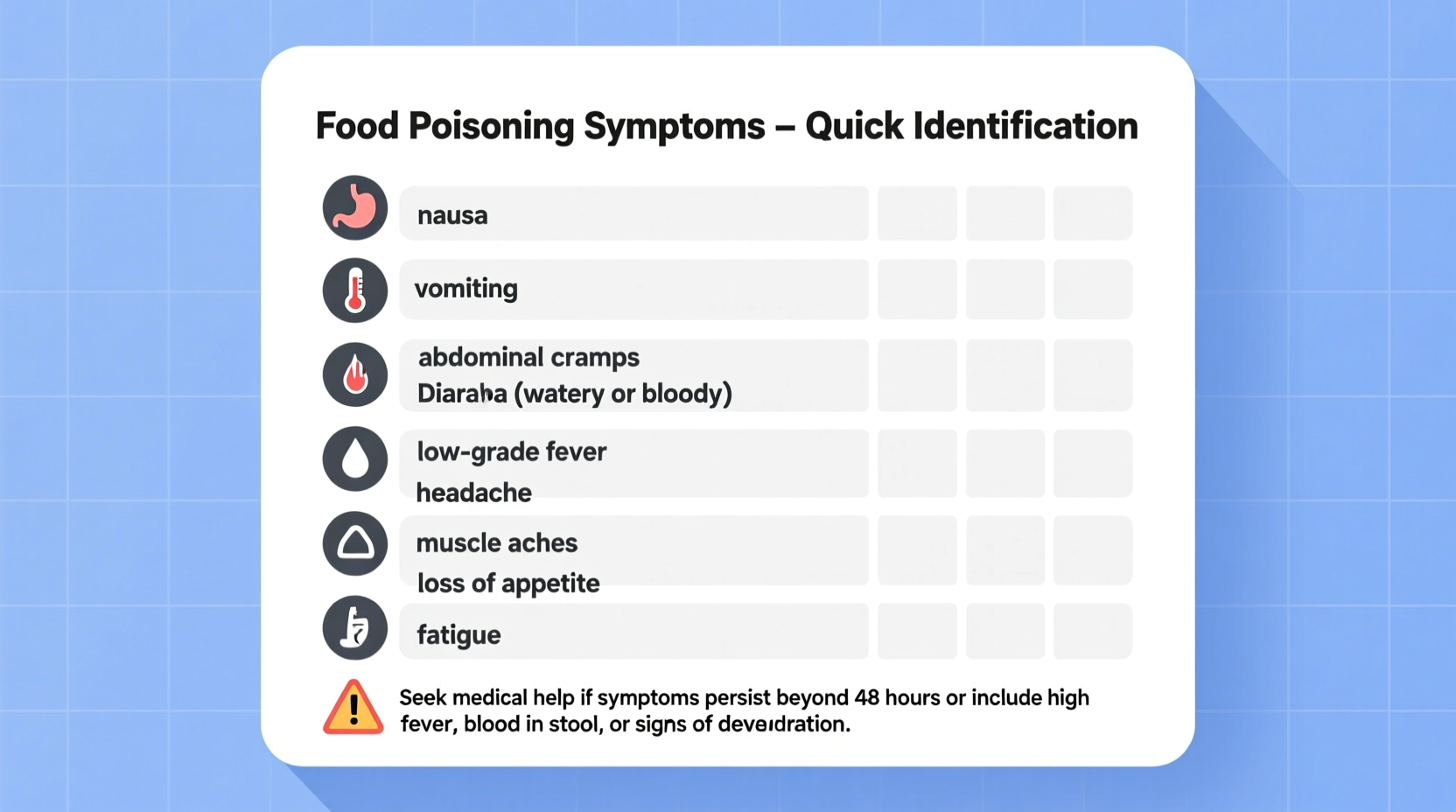If you're experiencing sudden nausea, vomiting, diarrhea, or stomach cramps within hours of eating, you likely have food poisoning. Key symptoms include watery diarrhea (often without blood), loss of appetite, fever above 100.4°F (38°C), and abdominal cramps. Most cases resolve in 1-3 days with rest and hydration, but seek immediate medical help for bloody stool, severe dehydration, or symptoms lasting over 3 days.
Recognize These Critical Symptoms Immediately
When food poisoning strikes, symptoms typically appear rapidly. Watch for these primary indicators within 30 minutes to 72 hours after eating contaminated food:
- Sudden watery diarrhea (the most common symptom affecting 90% of cases)
- Nausea and vomiting that starts abruptly
- Abdominal cramps and pain that may come in waves
- Fever between 100.4–102.2°F (38–39°C)
- Loss of appetite and weakness

Symptom Timeline: How Quickly Do Signs Appear?
The onset timing provides crucial clues about the contaminant. Based on CDC surveillance data, here's what to expect:
| Pathogen Type | Typical Onset Time | Duration |
|---|---|---|
| Staphylococcus aureus | 30 minutes – 8 hours | 1-2 days |
| Norovirus | 12-48 hours | 1-3 days |
| Salmonella | 6-72 hours | 4-7 days |
| E. coli | 3-4 days | 5-10 days |
This timeline helps differentiate food poisoning from viral gastroenteritis (stomach flu), which usually develops more gradually over 1-3 days with prominent respiratory symptoms. Foodborne illness typically hits faster and harder after a specific meal.
Food Poisoning vs. Stomach Flu: Key Differences
Many confuse these conditions, but critical distinctions exist. The CDC reports that 48 million Americans get food poisoning annually, while stomach flu affects 19-21 million. Use this comparison to identify your condition:
| Symptom | Food Poisoning | Stomach Flu |
|---|---|---|
| Onset speed | Sudden (within hours) | Gradual (1-3 days) |
| Diarrhea type | Watery, rarely bloody | Loose, may contain mucus |
| Fever | Moderate (100.4°F+) | Rare or mild |
| Respiratory symptoms | None | Common (cough, sore throat) |
| Source | Specific contaminated meal | Viral exposure |
When Home Care Isn't Enough: Critical Warning Signs
While most cases resolve with home treatment, certain symptoms require emergency care. The Mayo Clinic emphasizes immediate medical attention if you experience:
- Bloody or black stool (indicating intestinal damage)
- Signs of severe dehydration: dark urine, dizziness when standing, or producing little urine for 12+ hours
- Neurological symptoms like blurred vision or muscle weakness
- Fever exceeding 102°F (38.9°C)
- Symptoms persisting beyond 72 hours
High-risk groups including infants, elderly adults, pregnant women, and immunocompromised individuals should seek care at the first sign of symptoms. The CDC reports that 128,000 Americans require hospitalization annually due to severe foodborne illness complications.
Immediate Action Plan: What to Do Now
If you suspect food poisoning, follow these evidence-based steps:
- Hydrate strategically: Sip small amounts of oral rehydration solutions (like WHO's recommended formula) or clear broths. Avoid sports drinks with high sugar content.
- Rest completely: Your body needs energy to fight the infection. Avoid solid foods for 6-8 hours after vomiting stops.
- Track your symptoms: Note onset time, food consumed, and symptom progression. This helps medical professionals identify the pathogen.
- Preserve evidence: If possible, save a sample of the suspected food for testing (store in sealed container in freezer).
Do not take anti-diarrheal medications unless advised by a doctor, as they can prolong infection with certain pathogens like E. coli.
Preventing Future Episodes: Practical Safety Measures
Reduce your risk by implementing these food safety practices recommended by the FDA:
- Cook poultry to 165°F (74°C), ground meats to 160°F (71°C)
- Refrigerate leftovers within 2 hours (1 hour if temperature exceeds 90°F/32°C)
- Wash hands thoroughly before handling food and after bathroom use
- Use separate cutting boards for raw meats and produce
Remember that high-risk foods like raw shellfish, unpasteurized dairy, and undercooked eggs require extra caution. The FDA's Food Code specifies that perishable foods should never remain in the “danger zone” (40°F–140°F / 4°C–60°C) for more than 2 hours.
Frequently Asked Questions
How soon after eating contaminated food do symptoms appear?
Symptoms typically begin 30 minutes to 72 hours after exposure, depending on the pathogen. Staphylococcus can cause vomiting within 30 minutes, while E. coli may take 3-4 days to manifest. The CDC notes that most foodborne illnesses show symptoms within 12-72 hours.
Can food poisoning last longer than a week?
While most cases resolve in 1-3 days, certain infections like campylobacter or E. coli can persist for 7-10 days. If symptoms continue beyond 72 hours or worsen after initial improvement, seek medical evaluation as this may indicate complications requiring treatment.
What’s the difference between food poisoning and stomach flu?
Food poisoning stems from contaminated food and hits suddenly with prominent gastrointestinal symptoms. Stomach flu (viral gastroenteritis) develops more gradually, often includes respiratory symptoms like cough or sore throat, and spreads through person-to-person contact rather than specific foods.
Should I go to work with food poisoning symptoms?
No. The CDC requires that food handlers and healthcare workers stay home for at least 48 hours after symptoms end due to high contagion risk. For others, remain isolated until symptom-free for 24 hours to prevent spreading pathogens like norovirus, which remains contagious for days after recovery.











 浙公网安备
33010002000092号
浙公网安备
33010002000092号 浙B2-20120091-4
浙B2-20120091-4